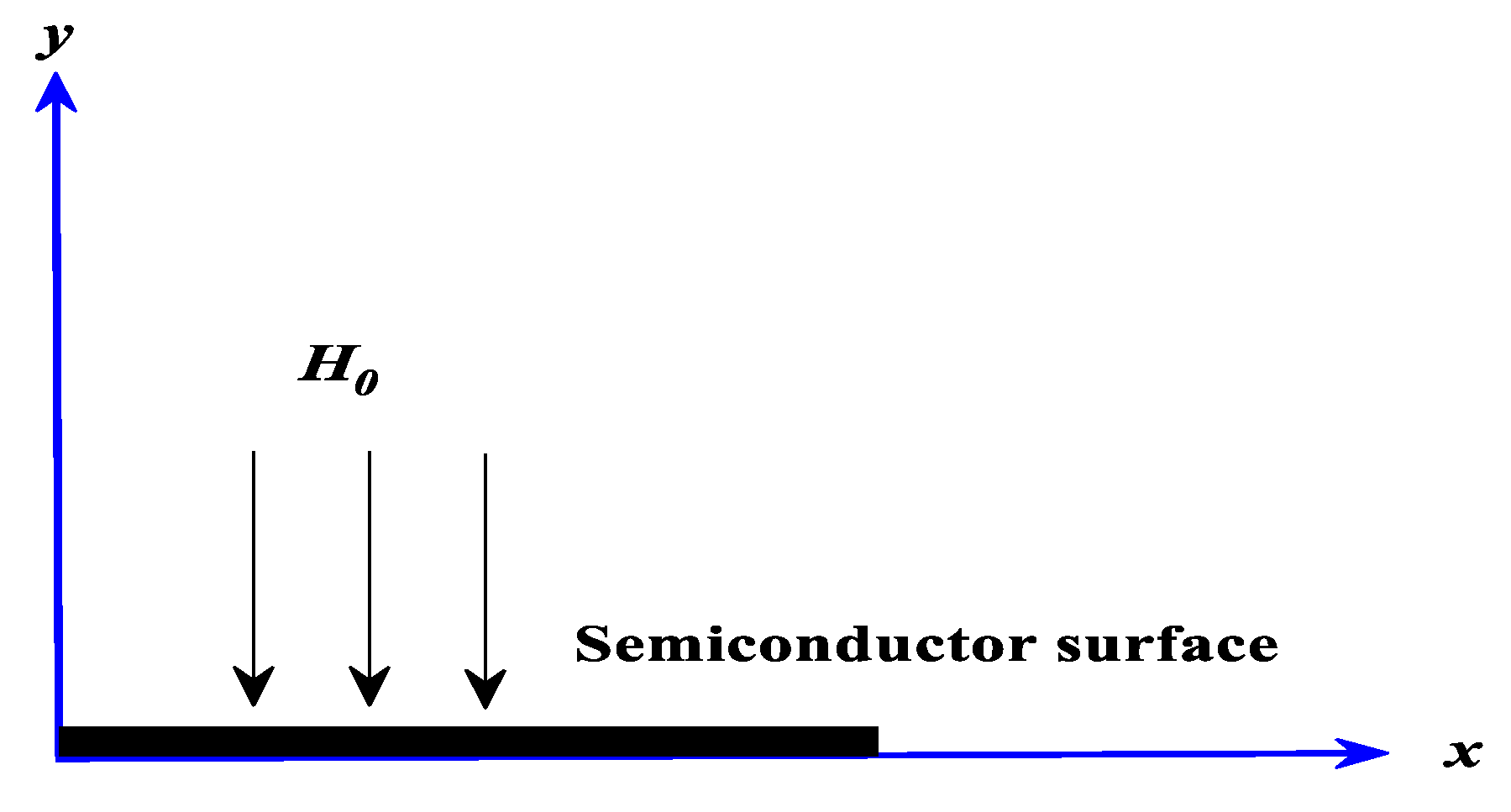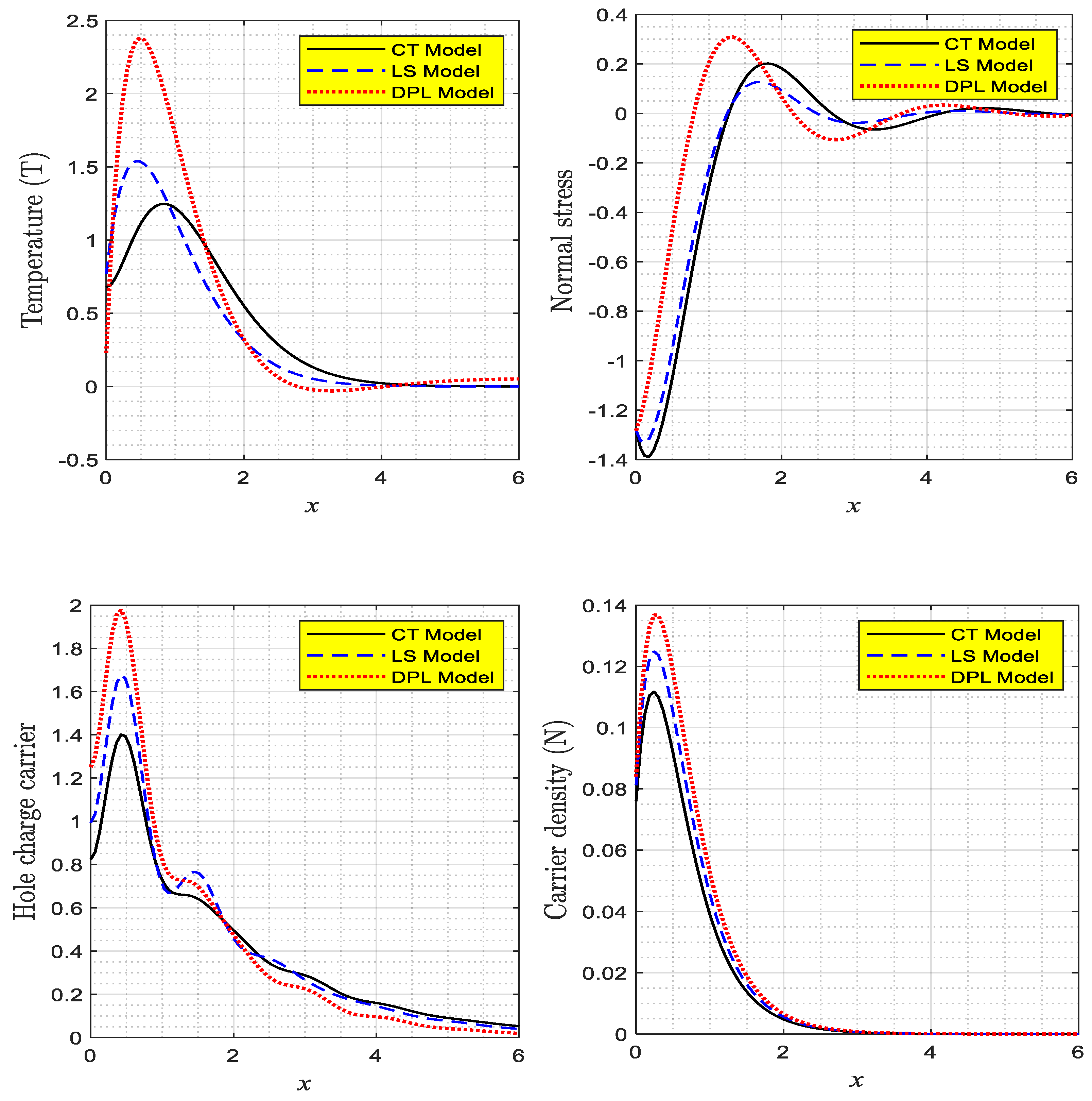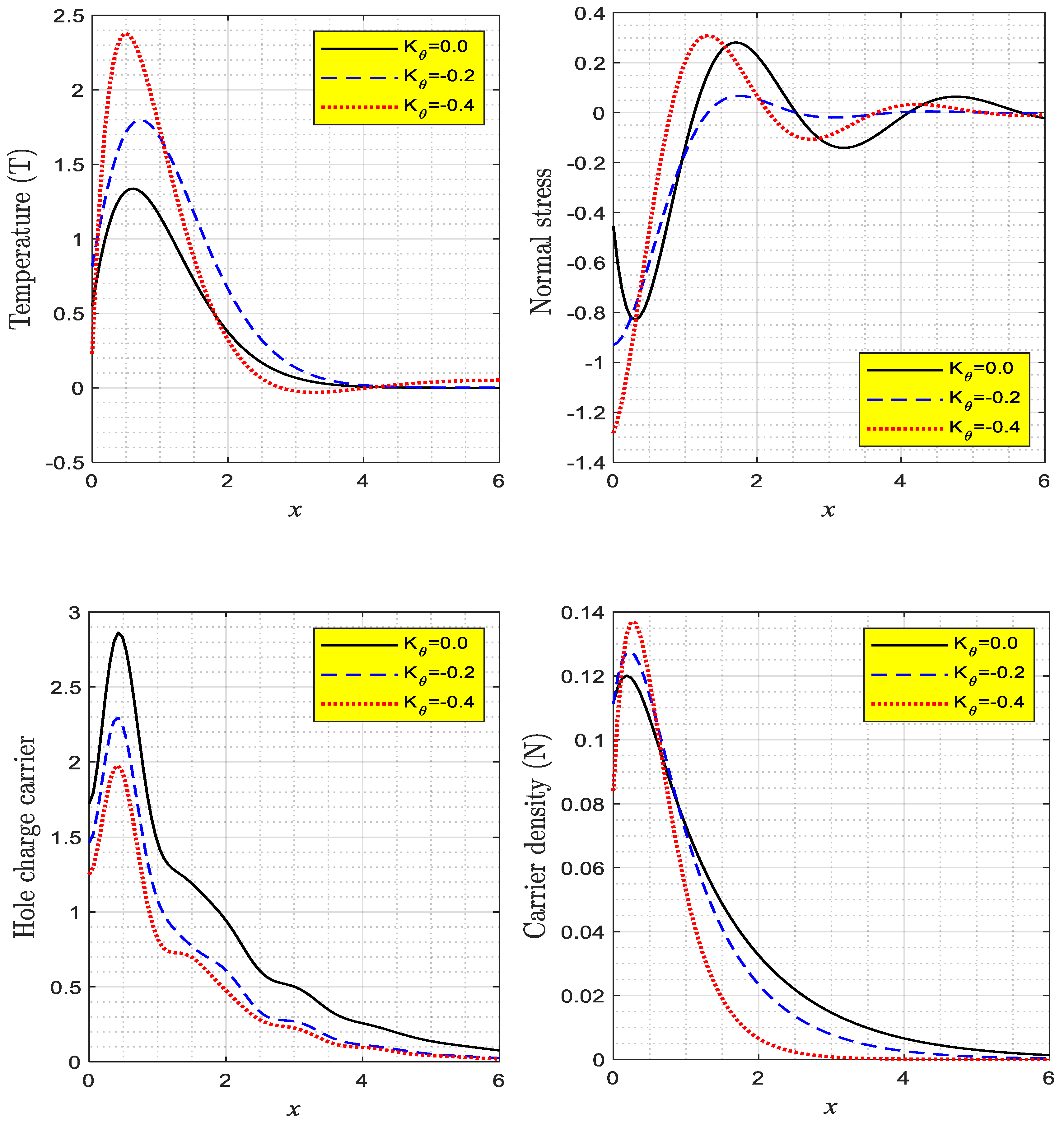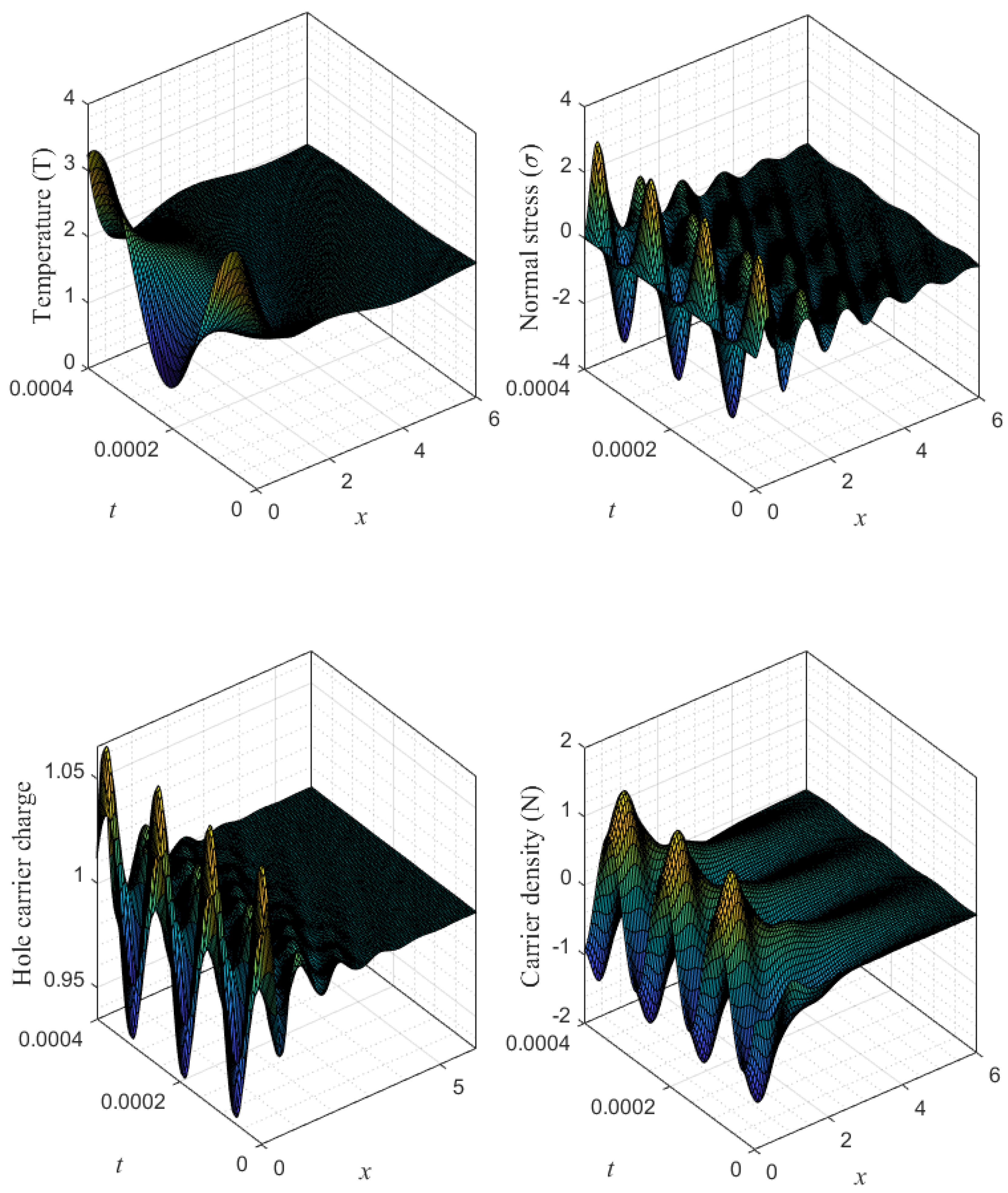Thermal-Diffusive Processes of an Electron-Hole Non-Local Semiconductor Model with Variable Thermal Conductivity and Hall Current Effect
Abstract
:1. Introduction
2. Governing Equation
3. Analytical Solution Procedure
4. Applications (Thermal Ramp Type)
- (I)
- (II)
- The mechanical condition at the free surface can be obtained with loaded force as:
- (III)
- When the carrier density spreads throughout the recombination processes and the medium is exhausted with mass and heat transmission, the plasma condition can be applied at the surface . However, this condition can be expressed as follows under the influence of the Laplace transform:
- (IV)
- During the optical-excitation processes at the surface , the recombination diffusion for the holes charge field also occurs, which, in the equilibrium situation, can be expressed under the Laplace transform as follows:where is a chosen (positive) parameter.
5. Inversion Processes of the Laplace Transforms
6. Validation
6.1. The Non-Local Photo-Thermoelasticity Models
- (1)
- When , expresses the dual phase lag DPL model.
- (2)
- When , , expresses the Lord and Șhulman (LS) model.
- (3)
- When , expresses the coupled thermoelasticity (CT) model.
6.2. Effect of Strong Magnetic Field
6.3. The Non-Local Semiconductor Medium
6.4. The Non-Local Magneto-Photo-Thermoelasticity Theory with Variable Thermal Conductivity
6.5. The Impact of Thermal Conductivity
7. Numerical Results and Discussions
7.1. The Photo-Thermoelasticity Models
7.2. The Effect of Variable Thermal Conductivity
7.3. The Impact of Hall Current
7.4. The 3D Graph
8. Conclusions
Author Contributions
Funding
Institutional Review Board Statement
Informed Consent Statement
Data Availability Statement
Conflicts of Interest
Nomenclature (The Physical Quantities with Units)
| Elastic Lame’s Parameters | |
| Deformation potential difference between conduction and valence band | |
| Electronic deformation coefficient ED | |
| Reference temperature in its natural state | |
| Volume thermal expansion | |
| Stress tensor | |
| Density of the sample | |
| Linear thermal expansion | |
| Equilibrium carrier concentration | |
| Specific heat at constant strain | |
| Thermal conductivity of the semiconductor medium | |
| Electrons and holes relaxation times | |
| Lifetime of photogenerated carriers | |
| Energy gap | |
| Components of the strain tensor | |
| Peltier–Seebeck–Dufour–Soret-like constants | |
| Flux-like constants | |
| Thermal and elastic relaxation times | |
| Holes and electrons thermo-diffusive parameters | |
| Equilibrium holes concentration | |
| Holes elastodiffusive parameter | |
| Coefficients of hole deformation | |
| Recombination velocities | |
| Diffusion coefficients of electrons and holes |
Appendix A
References
- Todorovic, D. Plasma, thermal, and elastic waves in semiconductors. Rev. Sci. Instrum. 2003, 74, 582–585. [Google Scholar] [CrossRef]
- Hall, E.H. On a New Action of the Magnet on Electric Currents. Am. J. Math. 1879, 2, 287–292. [Google Scholar] [CrossRef]
- Biot, M.A. Thermoelasticity and irreversible thermodynamics. J. Appl. Phys. 1956, 27, 240–253. [Google Scholar] [CrossRef]
- Lord, H.; Shulman, Y.A. Generalized dynamical theory of Thermoelasticity. J. Mech. Phys. Solids 1967, 15, 299–309. [Google Scholar] [CrossRef]
- Green, A.E.; Lindsay, K.A. Thermoelasticity. J. Elast. 1972, 2, 1–7. [Google Scholar] [CrossRef]
- Chandrasekharaiah, D.S. Thermoelasticity with second sound: A review. Appl. Mech. Rev. 1986, 39, 355–376. [Google Scholar] [CrossRef]
- Chandrasekharaiah, D.S. Hyperbolic Thermoelasticity: A review of recent literature. Appl. Mech. Rev. 1998, 51, 705–729. [Google Scholar] [CrossRef]
- Sharma, J.N.; Kumar, V.; Dayal, C. Reflection of generalized thermoelastic waves from the boundary of a half-space. J. Therm. Stress. 2003, 26, 925–942. [Google Scholar] [CrossRef]
- Lotfy, K.; Abo-Dahab, S. Two-dimensional problem of two temperature generalized thermoelasticity with normal mode analysis undethermal shock problem. J. Comput. Theor. Nanosci. 2015, 12, 1709–1719. [Google Scholar] [CrossRef]
- Othman, M.; Lotfy, K. The influence of gravity on 2-D problem of two temperature generalized thermoelastic medium with thermal relaxation. J. Comput. Theor. Nanosci. 2015, 12, 2587–2600. [Google Scholar] [CrossRef]
- Maruszewski, B. Electro-magneto-thermo-elasticity of Extrinsic Semiconductors, Classical Irreversible Thermodynamic Approach. Arch. Mech. 1986, 38, 71–82. [Google Scholar]
- Maruszewski, B. Electro-magneto-thermo-elasticity of Extrinsic Semiconductors, Extended Irreversible Thermodynamic Approach. Arch. Mech. 1986, 38, 83–95. [Google Scholar]
- Maruszewski, B. Coupled Evolution Equations of Deformable Semiconductors. Int. J. Eng. Sci. 1987, 25, 145–153. [Google Scholar] [CrossRef]
- Sharma, J.N.; Thakur, N.T. Plane harmonic elasto-thermodiffusive waves in semiconductor materials. J. Mech. Mater. Struct. 2006, 1, 813–835. [Google Scholar] [CrossRef] [Green Version]
- Mandelis, A. Photoacoustic and Thermal Wave Phenomena in Semiconductors; Elsevier: New York, NY, USA, 1987. [Google Scholar]
- Almond, D.; Patel, P. Photothermal Science and Techniques; Springer Science & Business Media: Berlin/Heidelberg, Germany, 1996. [Google Scholar]
- Gordon, J.P.; Leite, R.C.C.; Moore, R.S.; Porto, S.P.S.; Whinnery, J.R. Long-transient effects in lasers with inserted liquid samples. Bull. Am. Phys. Soc. 1964, 119, 3–8. [Google Scholar] [CrossRef]
- Lotfy, K. Effect of variable thermal conductivity during the photothermal diffusion process of semiconductor medium. Silicon 2019, 11, 1863–1873. [Google Scholar] [CrossRef]
- Todorovic, D.M.; Nikolic, P.M.; Bojicic, A.I. Photoacoustic frequency transmission technique: Electronic deformation mechanism in semiconductors. J. Appl. Phys. 1999, 85, 7716–7726. [Google Scholar] [CrossRef]
- Tam, A.C. Applications of photoacoustic sensing techniques. Rev. Mod. Phys. 1986, 58, 381. [Google Scholar] [CrossRef]
- Lotfy, K.; El-Bary, A.A.; Hassan, W.; Ahmed, M.H. Hall current influence of microtemperature magneto-elastic semiconductor material. Superlattices Microstruct. 2020, 139, 106428. [Google Scholar] [CrossRef]
- Mahdy, A.M.S.; Lotfy, K.; Ahmed, M.H.; El-Bary, A.; Ismail, E.A. Electromagnetic Hall current effect and fractional heat order for microtemperature photo-excited semiconductor medium with laser pulses. Results Phys. 2020, 17, 103161. [Google Scholar] [CrossRef]
- Mahdy, A.M.S.; Lotfy, K.; El-Bary, A.; Tayel, I.M. Variable thermal conductivity and hyperbolic two-temperature theory during magneto-photothermal theory of semiconductor induced by laser pulses. Eur. Phys. J. Plus 2021, 136, 651. [Google Scholar] [CrossRef]
- Hosseini, S.; Sladek, J.; Sladek, V. Application of meshless local integral equations to two-dimensional analysis of coupled non-Fick diffusion elasticity. Eng. Anal. Bound. Elem. 2013, 37, 603–615. [Google Scholar] [CrossRef]
- Lotfy, K. A Novel Model of Photothermal Diffusion (PTD) fo Polymer Nano- composite Semiconducting of Thin Circular Plate. Phys. B Condens. Matter 2018, 537, 320–328. [Google Scholar] [CrossRef]
- Lotfy, K.; Hassan, W.; Gabr, M. Thermomagnetic effect with two temperature theory for photothermal process under hydrostatic initial stress. Results Phys. 2017, 7, 3918–3927. [Google Scholar] [CrossRef]
- Yadav, A. Photothermal plasma wave in the theory of two-temperature with multi-phase-lag thermo-elasticity in the presence of magnetic field in a semiconductor with diffusion. Waves Random Complex Media 2022, 32, 2416–2444. [Google Scholar] [CrossRef]
- Lotfy, K. A novel model for Photothermal excitation of variable thermal conductivity semiconductor elastic medium subjected to mechanical ramp type with two-temperature theory and magnetic field. Sci. Rep. 2019, 9, 3319. [Google Scholar] [CrossRef] [PubMed]
- Zhou, H.; Shao, D.; Li, P. Thermoelastic damping and frequency shift in micro/nano-ring resonators considering the nonlocal single-phase-lag effect in the thermal field. Appl. Math. Model. 2023, 115, 237–258. [Google Scholar] [CrossRef]
- Lata, P.; Singh, S. Effects of Hall current and nonlocality in a magneto-thermoelastic solid with fractional order heat transfer due to normal load. J. Therm. Stress. 2022, 45, 51–64. [Google Scholar] [CrossRef]
- Honig, G.; Hirdes, U. A method for the numerical inversion of LaplaceTransforms, Comp. Appl. Math. 1984, 10, 113–132. [Google Scholar]
- Marin, M. A partition of energy in thermoelasticity of microstretch bodies. Nonlinear Anal. Real World Appl. 2010, 11, 2436–2447. [Google Scholar] [CrossRef]
- Abbas, I.; Marin, M. Analytical Solutions of a Two-Dimensional Generalized Thermoelastic Diffusions Problem Due toLaser Pulse. Iran. J. Sci. Technol. Trans. Mech. Eng. 2018, 42, 57–71. [Google Scholar] [CrossRef]
- Mondal, S.; Sur, A. Photo-thermo-elastic wave propagation in anorthotropic semiconductor with a spherical cavity and memory responses. Wavesin Random Complex Media 2021, 31, 1835–1858. [Google Scholar] [CrossRef]
- El-Sapa, S.; Lotfy, K.; El-Bary, A. The Hall current effect of magnetic-optical-elastic-thermal-diffusive semiconductor model during electrons-holes excitation processes. Waves Random Complex Media 2022. [Google Scholar] [CrossRef]
- Mustafa, F.; Hashim, A.M. Plasma Wave Electronics: A Revival Towards Solid-State Terahertz Electron Devices. J. Appl. Sci. 2010, 10, 1352–1368. [Google Scholar] [CrossRef] [Green Version]
- Brancik, L. Programs for fast numerical inversion of Laplace transforms in MATLAB language environment. In Proceedings of the 7th Conference MATLAB, Prague, Czech Republic, 3 November 1999; Volume 99, pp. 27–99. [Google Scholar]
- Alhejaili, W.; Lotfy, K.; El-Bary, A. Photo–elasto–thermodiffusion waves of semiconductor with ramp-type heating for electrons–holes-coupled model with initial stress. Waves Random Complex Media 2022, 1–19. [Google Scholar] [CrossRef]
- Abbas, I.A. A GN model for thermoelastic interaction in an unbounded fiber-reinforced anisotropic medium with a circular hole. Appl. Math. Lett. 2013, 26, 232–239. [Google Scholar] [CrossRef] [Green Version]
- Abbas, I.A. Eigenvalue approach on fractional order theory of thermoelastic diffusion problem for an infinite elastic medium with a spherical cavity. Appl. Math. Model. 2015, 39, 6196–6206. [Google Scholar] [CrossRef]
- Abbas, I.A.; Abdalla, A.-E.N.N.; Alzahrani, F.S.; Spagnuolo, M. Wave propagation in a generalized thermoelastic plate using eigenvalue approach. J. Therm. Stress. 2016, 39, 1367–1377. [Google Scholar] [CrossRef]
- Abbas, I.A. Analytical solution for a free vibration of a thermoelastic hollow sphere. Mech. Based Des. Struct. Mach. 2015, 43, 265–276. [Google Scholar] [CrossRef]
- Abbas, I.A.; Alzahranib, F.S.; Elaiwb, A. A DPL model of photothermal interaction in a semiconductor material. Waves Random Complex Media 2019, 29, 328–343. [Google Scholar] [CrossRef]
- Xiao, Y.; Shen, C.; Zhang, W.B. Screening and prediction of metal-doped α-borophene monolayer for nitric oxide elimination. Mater. Today Chem. 2022, 25, 100958. [Google Scholar] [CrossRef]
- Liu, J.; Han, M.; Wang, R.; Xu, S.; Wang, X. Photothermal phenomenon: Extended ideas for thermophysical properties characterization. J. Appl. Phys. 2022, 131, 065107. [Google Scholar] [CrossRef]





| Unit | Symbol | Value | Unit | Symbol | Value |
|---|---|---|---|---|---|
Disclaimer/Publisher’s Note: The statements, opinions and data contained in all publications are solely those of the individual author(s) and contributor(s) and not of MDPI and/or the editor(s). MDPI and/or the editor(s) disclaim responsibility for any injury to people or property resulting from any ideas, methods, instructions or products referred to in the content. |
© 2023 by the authors. Licensee MDPI, Basel, Switzerland. This article is an open access article distributed under the terms and conditions of the Creative Commons Attribution (CC BY) license (https://creativecommons.org/licenses/by/4.0/).
Share and Cite
Alhashash, A.; Raddadi, M.H.; El-Bary, A.A.; Chteoui, R.; Mhemdi, A.; Lotfy, K. Thermal-Diffusive Processes of an Electron-Hole Non-Local Semiconductor Model with Variable Thermal Conductivity and Hall Current Effect. Mathematics 2023, 11, 264. https://doi.org/10.3390/math11020264
Alhashash A, Raddadi MH, El-Bary AA, Chteoui R, Mhemdi A, Lotfy K. Thermal-Diffusive Processes of an Electron-Hole Non-Local Semiconductor Model with Variable Thermal Conductivity and Hall Current Effect. Mathematics. 2023; 11(2):264. https://doi.org/10.3390/math11020264
Chicago/Turabian StyleAlhashash, Abeer, Merfat H. Raddadi, Alaa A. El-Bary, Riadh Chteoui, Abdelwaheb Mhemdi, and Khaled Lotfy. 2023. "Thermal-Diffusive Processes of an Electron-Hole Non-Local Semiconductor Model with Variable Thermal Conductivity and Hall Current Effect" Mathematics 11, no. 2: 264. https://doi.org/10.3390/math11020264
APA StyleAlhashash, A., Raddadi, M. H., El-Bary, A. A., Chteoui, R., Mhemdi, A., & Lotfy, K. (2023). Thermal-Diffusive Processes of an Electron-Hole Non-Local Semiconductor Model with Variable Thermal Conductivity and Hall Current Effect. Mathematics, 11(2), 264. https://doi.org/10.3390/math11020264








